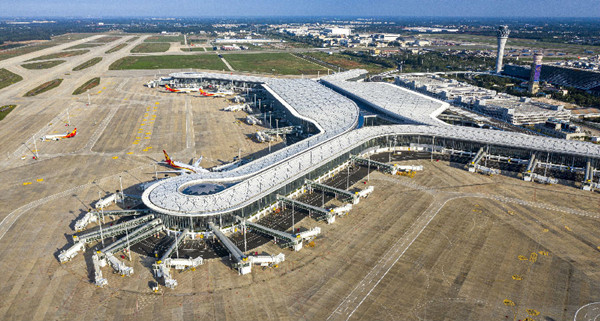
A bird's-eye view of the phase II project of the expansion of Haikou Meilan International Airport in Haikou, South China's Hainan Province [Photo/sasac.gov.cn]
Phase II of the expansion of Haikou Meilan International Airport in Haikou, capital of South China's Hainan Province, opened on Dec 2.
The project, constructed by China State Construction Engineering Corporation, has the first 4F-level flight area in Hainan. With a 3,600-meter long and 60-meter-wide runway, the airport can accommodate the A380, the world's largest passenger aircraft.
The T2 terminal of the phase II project covers about 300,000 square meters and has one central main building and four corridors. One hundred and ten check-in counters are set up in the terminal as is the DCV high-speed pallet luggage picking up system that improves luggage management efficiency.
After check-in, passengers can go through the corridor to board their flight.
During construction, more than 900 seismic isolation supporters were installed under the terminal, which improved its anti-earthquake capacity and reduced use of steel structure.
It's worth mentioning that the terminal is also equipped with a natural light introduction system and highly-efficient cooling and irrigation facilities, making it a green, low-carbon and environmentally-friendly venue.
Similar to the T1 terminal, T2 was also designed with local elements like coconut trees, boathouses and beaches, making passengers feel as if they are walking on an island.
A nearly 10,000 square meter duty-free shop is also included in T2. It is currently the largest airport offshore duty-free zone in China.
The phase II project plays a key role in construction of the air-land-sea traffic system and enhances connectivity with countries participating in the Belt and Road Initiative. It is also a base for development of the tourism and airport logistics industries in the Hainan Free Trade Port.
It is expected to be able to handle 35 million passengers and 400,000 metric tons of cargo and mail annually by 2025.
Upon operation, the phase II project will contribute to construction of a highly-efficient and convenient traffic transit system integrating aviation, railways and highways.
(Executive editor: Niu Yilin)